Positive Health Online
Your Country

Yoga and Breathing Exercises for Mother and Child
by Elizabeth Irvine(more info)
listed in yoga, originally published in issue 65 - June 2001
Yoga, along with breathing and meditation, can greatly benefit adults and children
Stress
Stress, pressure, not enough time in the day to squeeze it all in...words that ring a bell?
I believe people throughout the world share a common link of similar problems and stress.
Day-to-day wear and tear of today's fast paced and demanding lifestyle takes its toll on all of us. Our bodies can only put up with it for so long until this 'stress' manifests into a physical or emotional problem.
One of the first steps in managing stress is to become aware of it. How many times at the end of the day, do you sit back and reflect over the past ten hours and say, "Wow, what a great day! I didn't feel rushed, tired, angry, overwhelmed, frustrated or just plain cranky at any time during the day"? Recognizing your feelings is a huge step on the path to controlling them.
What I have to offer you is a 'taste' of some simple methods or 'remedies' to help combat the battle of stress and all its negative side effects. If we can learn how to incorporate this into our life, it can give our body the opportunity to perform as the amazing machine that it is.
Dr Andrew Weil MD, graduate of Harvard Medical School, director of integrative medicine at the University of Arizona, and probably America's best-known doctor, states so accurately in his book Spontaneous Healing, "I have titled my book Spontaneous Healing because I want to call attention to the innate, intrinsic nature of the healing process. The body can heal itself. It can do so because it has a healing system. At every level of biological organization, from DNA up, self repair and regeneration exist in us."[1]
Yoga and Breathing as 'Remedies'
Yoga and its key partners, breathing and meditation, can provide a natural 'treatment' to alleviate some of the physical and emotional problems that occur.
The first step is helping ourselves, and the next step is passing on the benefit to our children.
History of Yoga
In a nutshell, yoga is thought to be around 5,000 years old and was designed to help unite mind, body and spirit. The benefits of yoga can reach far beyond helping to improve balance and flexibility. The true essence is the connection between body and mind and is the link in keeping ourselves happy and healthy. Yoga can also help enhance a feeling of well-being and self-esteem. It requires a certain degree of concentration, encouraging the mind to focus on one thing (which is a wonderful discipline) and thus bringing a greater sense of clarity. Such skills are very useful in concentration and attention span for both adults and children.
Asanas
Postures (asanas) are the positions of yoga. My interpretation is allowing your body to move slowly and effortlessly, while keeping your mind completely focused on your breath, which allows the movement to happen. The author of Awakening the Spine, Vanda Scaravelli said, "Do not fight your body. Drop that heavy load. Do not kill the instinct of the body for the glory of the pose. Listen to your body, watch it, observe its needs, its requests, and even have fun. Play with it as children do. The body has its own intelligence and is willing to cooperate, one only has to have patience and attention. To be sensitive is to be alive."[2] Vanda Scaravelli studied for many years with BKS Iyengar and trained teachers who teach her form of yoga all over the world prior to her death last year at the age of 90 years old.
My yoga tutors, John Stirk and Sandra Sabatini (students of Scaravelli), Ginny Kempster and Ingrid Kottler, all follow Scaravelli's approach to yoga. It is the way I was taught and it is the way I teach my children.
Yoga for Children
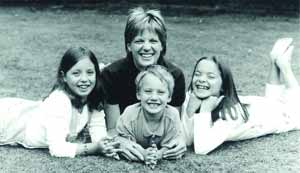
Elizabeth Irvine - Author with her three children. Left to right: Allie, Sam and Sarah.
What started out as a 'taster' session to introduce children to yoga at a girls' school has turned into a popular weekly lunchtime yoga class. I have enjoyed this as much as the girls, because it has been made so obvious to me how open and uninhibited children can be. They have the instinctive ability to focus on their breath and watch how their bodies respond. They make it seem like child's play, and when we remain open and focused it can happen for us too. I call my session yoga, but maybe more appropriately it should be referred to as 'breathing and body awareness'.
I have also been conducting a study for the past year, by which the behaviour of children is observed and documented for an afternoon after a yoga session and again on an afternoon without yoga. The results have been most pleasing. Increased cooperation, more attentive, happy, relaxed and feeling secure in themselves are the findings. This collection of data has encouraged me more than ever to practise with my own children as well as passing on the awareness to others of how yoga can help.
Putting It into Practice
With yoga, the ideas and objectives are the same for children as for adults; the key being to make the sessions short, fun and varied, so as to keep the children interested and involved. My own children usually practise for about 15 minutes, which includes some simple, focused breathing, a couple of animal poses (which sometimes end up in giggles) and we then finish off with a visual relaxation. Most importantly, we've all experienced a peaceful time together, an awareness of our body, and a sense of revitalization.
Following are a few of my favourite simple breathing exercises, postures, and a visual meditation.
Begin by practising on your own until you are comfortable with the technique. Start slow, take your time, and enjoy the feeling of being cleansed from the daily stress. After you feel the peacefulness and revitalization, then you will be able to pass the benefits on to your children.
The following exercises are meant to give you a sample of what yoga, breathing and meditation can provide. If you enjoy these, try one of the books/tapes I have listed at the end, or find a class to develop your understanding further.
I am currently working on a book (with accompanying CD), Healthy Mother: Healthy Child, incorporating yoga postures, breathing, simple meditation and nutrition as 'remedies' to alleviate specific problems and work towards improved health and vitality.
Breathing
Physiologically, the breath is closely linked to the circulatory system. The air (containing oxygen) that we breathe into our lungs is transferred into our blood which travels around our body delivering oxygen to our brain, organs and all other parts of our body. Just prior to completing the breath's cycle, we exhale (the out-breath) and get rid of the by-product called carbon dioxide. Then the cycle begins again.
Learning how to observe and control one's breath is an essential part of yoga practice. Besides the obvious physiological benefit, breathing slowly and deeply, and using the abdomen, has another advantage. It helps to remove feelings of stress and anxiety and to encourage a more relaxed, contented outlook. Children can feel just as 'stressed out' as adults, particularly around exam time. Yoga brings a conscious attention to the continual gift of life – breathing.
Balloon Tummy Breathing
This is an exercise that I use in my class and with my own children.
1. Start from either relaxation position: lying down – flat on the back, the arms a few inches away from the body, palms facing up and the legs shoulder width apart, feet relaxing sideways; or sitting – crossed leg, lotus, or on a cushion. Most importantly keeping spine straight but not rigid.
2. My children prefer to keep one hand resting gently over the abdomen so they can feel the movement. It is important to remind them to focus only on what you are saying and their breath.
3. Ask the children to close their eyes and imagine that there is a round, very soft balloon in their tummy. They can choose a colour for this balloon.
4. Now breathe in slowly (always through the nose), and see the balloon very carefully and delicately filling up as their tummies rise slowly and gently up towards the sky (without pushing them up). When they breathe out slowly, lightly, again through their nose, they see the balloon emptying and feel their tummies softly flattening. Tell them not to force it, just let it happen naturally. They can repeat this exercise five times to begin with. Then you can ask them how they feel.
This exercise should help keep the child's total awareness on the movement of the breath and be both calming and relaxing, as well as encouraging good breathing patterns.
Alternate Nostril Breathing (Nadi: Sodhana)
(Breathing with one nostril at a time; purifying the channels in which energy/air flow.)
1. Begin by sitting in the position in which you are most comfortable (as described above), most importantly with the spine straight.
2. Place the thumb and fourth finger on each side of the nose, and let the other fingers rest on the bridge of the nose. Breathe through one nostril, while blocking the air passage from the opposite side. Inhale from one nostril and exhale from the other; inhale from the same nostril and exhale from the other (closing and releasing the nostrils with alternate thumb or finger). Breathe slowly, softly, evenly and deeply. This is one round. Practise five times, increasing to ten when comfortable.
(If it seems too complicated to use one hand, try using both hands, covering alternating nostrils with the index finger from the right and left side).
This exercise creates a state of calmness and tranquillity. The flow of breath is equalized. It cleanses the blood of toxins. It relieves pressure from the forehead and magically headaches disappear.
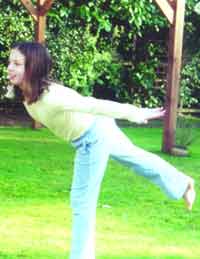
Allie Irvine - 'Balance'
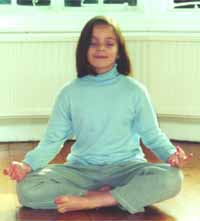
Sarah Irvine - 'Meditation'
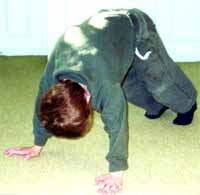
Sam Irvine - 'Dog Pose'
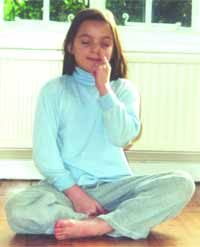
Sarah Irvine - 'Alternate nostril breathing'
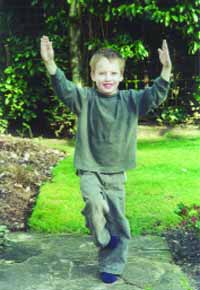
Sam Irvine - 'Tree Pose'
Asanas
Mountain Pose (Tadasana)
My children call this pose 'magic feet'.
1. Stand with the feet hips width apart. Keep the spine straight but relaxed, and the chin in. Put equal weight on each leg. Breathe in and out through the nose slowly and gently.
2. Close your eyes and feel your feet sinking into the ground. Feel like you have huge, heavy, giant's feet spreading deeply into the ground. Breathe deeply and quietly. Now wriggle your toes, lift your big toe and try to keep the small ones on the ground. Next lift all of your small toes, and keep the big toe on the ground. Breathe softly and effortlessly.
3. Relax and drop your shoulders. Breathe deeply, quietly, gently. The whole body is completely relaxed.
Sandra Sabatini writes so elegantly in her new book Breath, the Essence of Yoga, "There is this contact between our feet and the ground, there is this powerful friend – gravity, that pulls our feet, our heels, back into the ground. Then there is this external ally space – the sky, which also attracts the top of our spine. So just by simply being, by simply standing, the body is already encouraged to move in a different dimension. Your body is communicating with the ground underneath, and the space above. This interaction makes an incredible difference to your well being."[3]
This pose, done correctly, is a very important position. It is a pose you can do anywhere, anytime. It's a great way to give your body a break from the stress of the day. This position helps children in correcting their posture by straightening their spine, which is really great for a growing young body.
Dog Pose (Adho Mukha Svanasana)
I tell my kids to think of our dog, or a dog that they know. I ask them to see that dog in their mind and pretend that they are the dog.
1. Start with the hands and knees on the floor (your knees and hands have become the paws of the dog). Breathe slowly and smoothly.
2. Tucking the toes under, exhale 'growling like a dog', and raise the buttocks into the air. Try to imitate a dog that stretches when he gets up from his nap. (Please take care not to strain the muscles at the back of your legs – the hamstrings.)
3. Stay in this position for as long as you are comfortable, remember to keep breathing softly and with attention.
According to Scaravelli, "elongate the spine, like a dog, after all, all quadruped animals are elongating their spine with each step. We are less lucky."
This pose stretches and tones the hamstrings, Achilles' tendon, and calf muscles. This pose also brings a fresh blood supply to your head, clearing your mind, keeping your skin healthy, overall is a fantastic pose for the whole body.
Meditation/Visual Imagery/Relaxation
"In the rush of modern life, we tend to lose touch with the peace that is available in each moment. The most profound satisfactions, the deepest feelings of joy and completeness, lie as close at hand as our next aware breath and the smile we can form right now." Spoken so beautifully by Zen master, peace activist and author, Thich Nat Hanh.
My understanding of meditation is to make the mind quiet or still. Basically emptying the mind of all those thoughts that swirl around up there. In doing this we create an open, clear, quiet space. Therefore we can train our mind (and so our attention) to be calm, clear and focused. Learning to do this in only a small way can help so much. The benefits that I have experienced in taking the time to meditate are: feeling as though my batteries have been charged, seeing things crystal clear, and having an unshakeable security about myself.
Here is a very simple method that I used to learn how to meditate:
Sitting upright (with the spine straight) in a comfortable position, let your feet or sitting bones sink into the ground like they were the roots of a huge tree. Feel the base of your spine drop. Close your eyes and focus on your breath; feel it deep down in your abdomen. Imagine your breath like the wave of the ocean (by slowing down and deepening the breath we actually release calming alpha waves). Watch your breath come in and out again. Breathe in deeply and softly; breathe out slowly and gently. Try to breathe with the waves; count them, see them, smell them. Don't get frustrated if your mind wanders, just gently bring it back to focusing on your breath and the wave. Tell yourself, "I am breathing in, I am breathing out". Sometimes it is easier than at other times; whatever happens is fine. Try to practise five minutes a day.
What greater gift can we give our children than the gift of inner peace? Teaching our children to meditate in a very simple and natural way gives them just that gift, a gift that will remain with them for the remainder of their lives. Hopefully, this will lead to a world full of more confident and centred adults who can create a brighter future for us all. You're probably thinking this will not be as easy as it sounds. Just try the following exercise and see what you think!
Bedtime is an excellent opportunity to try this out. If your children are anything like mine, one more reason to avoid 'lights out' is welcomed with open arms. This meditation is my adaptation from the book Moonbeam.[4] It is one of my children's favourites.
Get comfortable and take some deep, soft breaths in and out.I want you to see a star above your head. It is very special to you as it is your very own star. You need to choose a colour for it because it belongs to you and no one else has one like it. The star is filled with a glowing, shimmering light of the colour you have chosen. Now see the light coming down from the star and coming into your head. Feel this pure, sparkling, shimmering light fill your body, from the top of your head, down your arms and into your fingers, down into your tummy, into your legs, and right down to your toes. Now look into your heart and fill it with love for all the people and animals you know (adapt to your situation). Remember they are your friends. Do you feel the love that is in your heart? Can you see it getting bigger? It is getting bigger because you have so much love in your heart for all these people and animals, and of course, you. Your Guardian Angel is now waiting for you to wrap a golden bubble of protection around you and to take you to the Worry Tree. Here you can hang anything that worries you. Leave all your worries behind and your Guardian Angel will open the gate and take you inside the garden. Your garden is filled with the most beautiful flowers. The grass and trees are an emerald green and the sky is bright blue with white clouds like cotton balls… (At this point you can take the visualization anywhere or simply finish it here. The adventure is for you and your children to discover.)
Discovering yoga, breathing and meditation were such 'treasures' to me. The benefits they brought in combating the daily wear and tear of this modern, fast paced, stressful life were something so valuable as well as enjoyable that I wanted my kids to experience them too.
Why not try it for yourself and with your children? Even a few minutes of quiet time each day spent together can give such positive results.
References
1. Weil A. Spontaneous Healing. Ballantine. 1995.
2. Scaravelli V. Awakening the Spine. Harper Collins. 1991.
3. Sabatini S. Breath, the Essence of Yoga. Thorsons. 2000.
4. Garth M. Moonbeam (a Book of Meditations for Children). Harper Collins. 1992.
Further Books and Resources
Kempster Ginny. Yoga at Home with Ginny Kempster (audio tape).
Ginny Kempster teaches in the Surrey area and holds a teaching diploma from the British Wheel of Yoga. To contact Ginny or a teacher in your area contact the British Wheel of Yoga on tel: 01529 306 851.
Living Arts. Yoga Kids (video tape). Living Arts. 1996. Tel: 1 800 254 8464.
Saraswati S. Yoga Education for Children. Bihar School of Yoga. 1985.
Weller Stella. Yoga for Children. Thorsons. 1996.
For further information, please refer to Elizabeth Irvine's website at www.truewellbeing.co.uk
Comments:
-
No Article Comments available